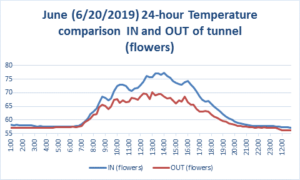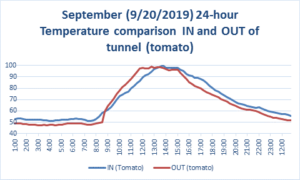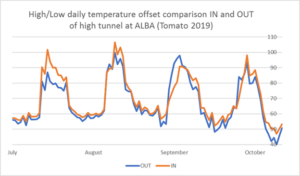Final report for OW17-043
Project Information
Since 2001, the Agriculture and Land-Based Training Association (ALBA) has provided educational, marketing and farm business opportunities to aspiring, beginning, and socially-disadvantaged farmers on 100 certified organic acres in the heart of the Salinas Valley.
Launching a small farm business in the Salinas Valley, a multi-billion dollar agricultural industry, may seem like a challenging proposition. The prime agricultural land in the region is dominated by large farms that grow a limited range of vegetable crops and berries on a large scale with a focus on high yields and efficiency. Most of the product is exported around the country and world, hence the name ‘Salad Bowl of America’. However, the growing demand for local and organic produce has created a tangible alternative opportunity for ALBA’s small-scale farmers. ALBA is located less than 100 miles from the San Francisco Bay Area, one of the largest markets for organic produce in the nation. Our food hub, ALBA Organics, aggregates and markets the produce of our small farmers and has returned $15 million to these growing businesses since 2010. However, small-scale farmers must continually innovate and adapt to maintain their foothold in the region’s competitive markets, whether selling wholesale or direct-to-consumers.
Extending the season and raising productivity with a high tunnel is one such approach. A high tunnel is a portable structure that is covered in UV resistant polyethylene plastic. It has the ability to roll up the sides and open both ends to supply ventilation for both air movement and temperature control. The use of these structures is not without precedent at ALBA. From 2010-12, ALBA provided outreach and education to help regional farmers pilot the NRCS high tunnel cost-share, resulting in 8 tunnels being built on our land. The NRCS’ high tunnel promotion was based on the idea that these structures, by extending the season, could increase the amount of food grown with less transportation miles and associated CO2 emissions.
Since the pilot, ALBA farmers have continued to successfully build high tunnel structures, mostly with the help of cost-share through the NRCS Environmental Quality Incentives Program. However, the results have been mixed with a few farmers achieving high levels of productivity and profitability while many others have struggled with basic planning and production issues. Furthermore, since ALBA’s work with the NRCS, many of the tunnel structures have been sold by farmers transitioning off ALBA’s land to a new generation of farmers in the Organic Farm Incubator. Indeed, the proposed project is uniquely poised to leverage past work, and address the interest and needs of a new generation of ALBA farmers who want to get started and improve their ability to grow in high tunnels.
All over the country, high tunnel production has shown promise as a low-cost way for farmers to increase profits by extending the growing season. While extension of a harvest season is a key component to an increased yield on a given piece of land -- and thus a direct and important contributor to potential profitability -- it also has important secondary effects. The amount of time a farmer is able to bring a crop to market adds value to any wholesale buyer or direct buyer of consistent volume, such as a restaurant. Even a two week extension on either (or both) sides of the season often brings the additional advantage of higher prices and the coveted first-to-market position.
While season extension is the most discussed advantage of high tunnel use, it also:
· Shortens the period from planting to harvest, potentially adding more production cycles.
· Increases crop quality, yield and pack-out rate through several means, such as keeping off unwanted rains; reduction of pests; reduction of wind; and providing a structure for vertical growing.
· Provides a year round work space. With labor in short supply in California, year round work can help retain workers. High tunnels can provide a place to maintain work even during rainy and cold weather.
· Allows for transplant production. Large nurseries either decline or charge high rates for growing out small batch orders of transplants. A tunnel structure allows a space for farmers to grow some of their own transplants.
· Reduces water use and associated addition of salts, chlorine and other harmful elements to the soil
· Less fertilizer and pesticide inputs; and prevention of chemical drift.
Regionally, there are anecdotes of high yields and increased crop quality of vegetable crops for farmers utilizing high tunnels, however there has been little research performed to support these claims. The Salinas Valley is a region with a very mild climate, and many of the tools, research and resources related to high tunnel production are focused on colder regions and also not available bilingually. A key feature of the project will be the high tunnel research performed by project project professionals (PP) and farmers (F) in ALBA’s demonstration field and leased parcels:
Ø Side-by-side trials (in and out of tunnel) for at least five different vegetables crops (PP&F);
Ø Measurements on days to maturity, yield, and pack-out rate (PP&F);
Ø Temperature inside the high tunnel throughout the season (PP);
Ø Regular observation of pest pressure and irrigation needs (PP).
ALBA’s Beginning-farmer Research and Instruction on Growing in High Tunnels (BRIGHT) project will help fill an important research gap and provide the on the ground technical assistance that ALBA farmers need to achieve higher levels of productivity with this technology.
The goal of BRIGHT is to perform research and provide education that advances high tunnel production amongst small-scale farmers in the
Salinas Valley.
I. Perform innovative research on high tunnel production and disseminate results to a regional network.
The research and demonstration component of the project will add to the body of knowledge on high tunnel production for our area. Historically,
tunnels have had little use in vegetable crops in our region, but are widely used in caneberries. ALBA will construct a high tunnel (250’ x 24’ x
12’) in its 1.25 acre demonstration field. This tunnel will be used for research, as well as demonstration highlighted in trainings. Farmers will use
existing or new tunnels to perform their own research and provide demonstrations, as well. All of the research results will be integrated into
trainings, materials and tools, including a fact sheet mailed to 300+ regional, mostly Hispanic small-scale farmers.
II. Educate small-scale farmers on high tunnel production.
Over one hundred (100) aspiring and beginning farmers will demonstrate increased understanding of high tunnel production topics through 2
workshops per year, 1 high tunnel construction field day, and new educational tools. The training materials (presentation outlines, fact sheet, and a new ‘season extension’ section in the Organic Vegetable Production module) will be integrated into ALBA’s Farmer Education Course, providing
bilingual high tunnel production to farmers into the future.
III. Provide hands-on technical assistance to ‘core’ participants to improve high tunnel production.
Five farmers who are currently farming with high tunnels will receive extensive hands-on technical assistance that leads to improved productivity.
Services will include advising on ground preparation, crop selection, irrigation, fertilization, pest management, and tunnel maintenance and
improvements. We will also screen for and assist farmers applying for NRCS EQIP. The measurable results will include 75% increases in
productivity in the tunnel space for core participants by year 2, and three new tunnels being constructed.
Cooperators
- (Educator)
- (Educator)
Research
The Materials and Methods are related to objective 1 of the project:
I. Perform innovative research on high tunnel production and disseminate results to a regional network
The research and demonstration component of the project will add to the body of knowledge on high tunnel production for our area. Historically, tunnels have had little use in vegetable crops in our region, but are widely used in caneberries. ALBA will construct a high tunnel (250’ x 24’ x 12’) in its 1.25 acre demonstration field. This tunnel will be used for research, as well as demonstration highlighted in trainings. Farmers will use existing or new tunnels to perform their own research and provide demonstrations, as well.
Five core farmers and ALBA's demonstration field will be used for side-by-side trials. A crop will be grown inside the tunnel and the same crop adjacent to the tunnel. Farmers will choose which additional measurements to take, but will be required to track yield and days to maturity. Partner, the Resource Conservation District of Monterey County, will perform soil testing and measure temperature.
Table 1. Yield and days to maturity inside and outside of tunnel
|
CROP |
PLANTING DATE |
ACREAGE |
DAYS TO MATURITY (IN / OUT) |
CUM. HARVEST |
NOTES |
|
Kale |
11/2/17
|
.04 |
44 / 65 |
15 boxes / N/A |
Bird pressure devastated outside crop; tracked harvest for 6 weeks |
|
Chard |
11/2/17 |
.04 |
44 /65 |
17 boxes / 12 boxes |
Frost damaged outside crop; tracked harvest for 6 weeks |
|
Broccolini |
12/7/19 |
.04 |
63 / 77 |
96lbs / 38lbs |
Tracked harvest for 6 weeks |
|
Bok Choy |
8/4/20 |
.25 |
64 / 65 |
113 boxes / 90 boxes |
|
|
Red Leaf Lettuce |
8/15/20 |
.5 |
37 |
250 boxes |
No comparison to outside; though average lettuce yield for field grown is 600-800 boxes/ac and DTM is ~45 days from transplanting |
Table 2. ECe (ds/m) both in and out of high tunnel
|
Soil Analysis |
ECe (dS/m) |
||||
|
Block |
DATE |
IN |
OUT |
||
|
8 |
Dec-19 |
2.37 |
0.70 |
||
|
12 |
Dec-19 |
4.70 |
3.80 |
||
|
10 |
Dec-18 |
3.4 |
.64 |
||
|
100% Yield limit of soil ECe for selected crops |
|
||||
|
Crop |
Threshold ECe (dS/m) |
|
|||
|
Strawberry |
1.0 |
|
|||
|
Lettuce |
1.3 |
|
|||
|
Pepper |
1.5 |
|
|||
|
Celery |
1.8 |
|
|||
|
Tomato |
2.5 |
|
|||
|
Broccoli |
2.8 |
|
|||
|
Squash (zucchini) |
4.7 |
|
|||
Discussion:
In all trials, the days to maturity was shortened with the use of the high tunnel. We suspect this is mainly due to the increased heat units that the high tunnel environment provides relative to outside growing conditions. Cumulative harvest was generally higher for tunnel-grown ‘cut and come again’ type crops, such as, chard, kale and broccolini. However, the complete yield for each crop was not measured for these crops; rather the first 6 weeks. There was not much difference in DTM for bok choy in the trial, but yield and quality was higher in the tunnel compared to outside. Although no side-by-side trial was successfully performed with red leaf lettuce, it is worth noting that tunnel-grown lettuce had a DTM that is one week earlier than what is usually seen outside.
The relationship between the tunnel space and air temperature was too varied to draw any conclusions. Most of the tunnels did not have roll up side or doors, so would not have retained as much heat compared to one that did have such features. Also, they varied in sizes. We could assume that small and open tunnel structures would have less of a greenhouse effect. Some of the measurements showed the air temperature of the tunnel increasing more quickly during the day with higher peak temperatures achieved (see Graph 1); other rounds of measurements did not find the same (Graph 2). Thus, there could be some seasonal variation. One constant, however, was that the minimum temperature each night inside the tunnel spaces would drop relatively close to the ambient outside temperature (Graph 3). This is an important consideration for determining what to grow in a tunnel.
Although soil temperature was not directly measured, soil nitrate quick test results showed evidence of increased nitrogen mineralization rates within high tunnels. Samples collected in December also showed higher ECe values under tunnels, which prevent rainfall from reaching the soil and leaching accumulated salts. Soil health and fertility management will be a topic for ongoing consideration.
As with all tools on the farm, high tunnels have a limited lifespan and require maintenance and repair or replacement of components over time. From an environmental perspective, the plastic components (cover) are of significant concern if allowed to deteriorate and potentially enter the soil, air or ultimately, water. Programs that educate about and promote the use of high tunnels should include this aspect for consideration, for the ongoing costs associated with maintaining a high tunnel long-term, as well as options to mitigate environmental consequences
Research Outcomes
Education and Outreach
Participation Summary:
|
Activity Type |
Output |
|
Workshop and field days |
10 trainings reaching over 120 non-duplicated participants |
|
New tunnels |
6 constructed and/or rehabilitated totaling 1.4 acres |
|
Farmer-led trials |
4 farmer participants + 40 students performed/participated in side-by-side comparisons |
|
Data collection |
Temperature, days to maturity, soil data and yield |
|
Technical Assistance |
7 farmers received advising on tunnel management from ALBA staff, partners and farmer mentors |
|
Demonstration |
2 demonstration sites est. |
|
Products |
New PowerPoint presentations and the translation of a guide |
Link to project deliverables (Fact Sheet, Presentations, and High Tunnel Guide in Spanish):
https://drive.google.com/drive/folders/0BwSy06sVudUgWlBTSWg4NVB0LU0?usp=sharing
Education and Outreach Outcomes
Some areas of further study needed:
- This project was not able to evaluate the economic outcomes of high tunnel production. A number of ideas worth exploring:
- A crop by crop analysis of the economics of growing a crop inside or outside of a tunnel.
- How much does the extra management of the high tunnel production cost a farmer?
- We did choose to focus some of the project on caneberry production, as that is a more proven economic model.
- What kind of high tunnel is the best investment?
- NRCS tunnels have strict practice requirements, are more costly to install, and the cost share only covers a small area.
- Cheaper 'caneberry tunnels' are readily available and much less expensive.
- Does it even make sense in terms of efficiency for a farmer to try to manage a small tunnel space amongst the rest of their production? Perhaps, they need to go all in and put significant land in tunnels to facilitate operations.
- Irrigation management
- ETo was definitely higher in the peak summer months compared to outside ground, but appeared to be lower during the winter with less evaporation. There appear to be few resources on how to manage irrigation in tunnels.
- Pest pressure in the micro-climate of the tunnel appears to be a concern for central coast production and may require unique management approaches from field production.
- Elevated soil temperatures in high tunnels appear to result in higher mineralization rates, resulting in elevated soil nitrate levels relative to adjacent field conditions. Fertility management in tunnels requires independent consideration and testing.
Assessment of approach:
- Beginning farmer research poses special challenges. It is not insignificant to expect beginning farmers, without advanced educations in scientific disciplines, to engage in research and data-collection oriented projects. At times, there are more pressing concerns related to basic production and business operation needs. These farmers need direct technical support by a technical assistance provider, or an organizational or farm team staff member/employee who would be tasked with such responsibilities.
- Field demonstration and farmer mentors are important components of a successful farm education ecosystem. Farmers benefit the most by learning from other successful farmers, ideally ones from their community. Field demonstration is a way to put ideas into practice and learn by doing. This project benefited from 40 Farmer Education Course students engaging directly with high tunnel production as part of a student enterprise. The side-by-side trials performed in the first demonstration site were clearly visible to this group on a weekly basis.
- One should expect some crop failures and surprises in doing any kind of ag production research. One needs to plan for multiple planting windows and contingencies for performing the research. We were grateful to have had three years to carry out this project.
Season extension
High tunnel construction
Crop planning


